
Biliran, officially the Province of Biliran, is an island province in the Philippines located in the Eastern Visayas region. Biliran is one of the country's smallest and newest provinces. Formerly a sub-province of Leyte, it became an independent province in 1992.

Sorsogon, officially the Province of Sorsogon, is a province in the Philippines located in the Bicol Region. It is the southernmost province in Luzon and is subdivided into fourteen municipalities (towns) and one city. Its capital is Sorsogon City and borders the province of Albay to the north.
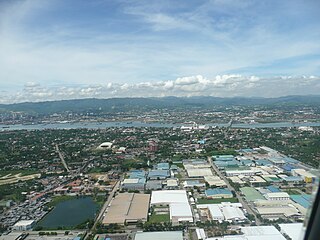
Lapu-Lapu City, officially the City of Lapu-Lapu, is a 1st class highly urbanized city in the Central Visayas region of the Philippines. According to the 2020 census, it has a population of 497,604 people.

Visayans or Visayan people are a Philippine ethnolinguistic group or metaethnicity native to the Visayas, the southernmost islands of Luzon and a significant portion of Mindanao. When taken as a single ethnic group, they are both the most numerous in the entire country at around 33.5 million, as well as the most geographically widespread. The Visayans broadly share a maritime culture with strong Roman Catholic traditions integrated into a precolonial indigenous core through centuries of interaction and migration mainly across the Visayan, Sibuyan, Camotes, Bohol and Sulu seas. In more inland or otherwise secluded areas, ancient animistic-polytheistic beliefs and traditions either were reinterpreted within a Roman Catholic framework or syncretized with the new religion. Visayans are generally speakers of one or more of the Bisayan languages, the most widely spoken being Cebuano, followed by Hiligaynon (Ilonggo) and Waray-Waray.

Mandaue, officially the City of Mandaue, is a 1st class highly urbanized city in the Central Visayas region of the Philippines. According to the 2020 census, it has a population of 364,116 people.
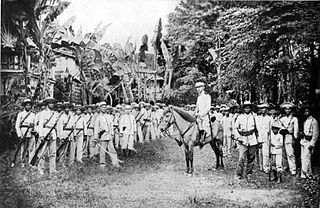
The Battle of Tirad Pass, sometimes referred to as the "Philippine Thermopylae", was a battle in the Philippine–American War fought on December 2, 1899, in northern Luzon in the Philippines, in which a 60-man Filipino rear guard commanded by Brigadier General Gregorio del Pilar succumbed to more than 500 Americans, mostly of the 33rd Volunteer Infantry Regiment under Major Peyton C. March, while delaying the American advance to ensure that President Emilio Aguinaldo and his troops escaped.

Samar is the third-largest and seventh-most populous island in the Philippines, with a total population of 1,909,537 as of the 2020 census. It is located in the eastern Visayas, which are in the central Philippines. The island is divided into three provinces: Samar, Northern Samar, and Eastern Samar. These three provinces, along with the provinces on the nearby islands of Leyte and Biliran, are part of the Eastern Visayas region.
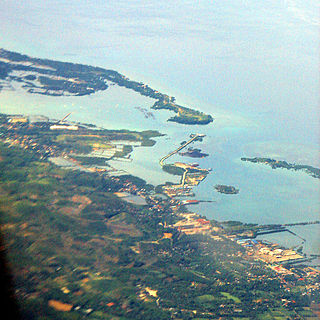
Carmen, officially the Municipality of Carmen, is a 3rd class municipality in the province of Cebu, Philippines. According to the 2020 census, it has a population of 57,897 people.
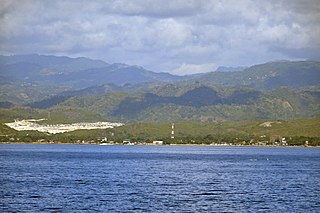
Compostela, officially the Municipality of Compostela, is a 3rd class municipality in the province of Cebu, Philippines. According to the 2020 census, it has a population of 55,874 people.
The Pulahan, also known as dios-dios, were the members of a religious revival of Philippine beliefs that developed in the Visayas prior to the Philippine Revolution. At its peak, it numbered around 10,000–15,000 adherents. The movement was severely crippled during the Philippine Revolution after the Philippine Constabulary took over patrols in Samar, when the U.S. military declared the island as "pacified".

Lila, officially the Municipality of Lila, is a 5th class municipality in the province of Bohol, Philippines. According to the 2020 census, it has a population of 12,240 people.

Gubat, officially the Municipality of Gubat, is a 2nd class municipality in the province of Sorsogon, Philippines. According to the 2020 census, it has a population of 60,294 people.
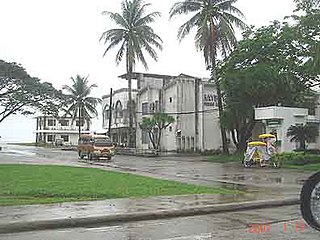
Baybay, officially the City of Baybay, is a 1st class component city in the province of Leyte, Philippines. It has a population of 111,848 people.
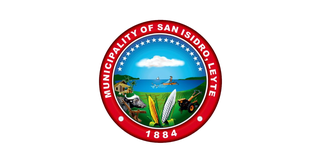
San Isidro, officially the Municipality of San Isidro, is a 4th class municipality in the province of Leyte, Philippines. According to the 2020 census, it has a population of 30,722 people.

Diego de los Ríos y Nicolau was a Spanish Lieutenant General who was known as the last Spanish Governor-General of the Philippines during the Spanish-American War. He also served in the Glorious Revolution, the Third Carlist War and the Ten Years' War.

Teresa Magbanua y Ferraris, better known as Teresa Magbanua and dubbed as the "Visayan Joan of Arc", was a Filipino schoolteacher and military leader. Born in Pototan, Iloilo, Philippines, she retired from education and became a housewife shortly after her marriage to Alejandro Balderas, a wealthy landowner from Sara, Iloilo. When the 1896 Philippine Revolution against Spain broke out, she became one of only a few women to join the Panay-based Visayan arm of the Katipunan, the initially secret revolutionary society headed by Andrés Bonifacio.
The elections for the Malolos Congress, also known as the Revolutionary Congress, were held in the Philippines from June 23 to September 10, 1898.

Historical markers are installed by the National Historical Commission of the Philippines (NHCP) in the Philippines and places abroad that signify important events, persons, structures, and institutions in Philippine national and local histories. The plaques themselves are permanent signs installed by the NHCP in publicly visible locations on buildings, monuments, or in special locations. Local municipalities and cities can also install markers of figures and events of local significance. Though they may have the permission of the NHCP, these markers are barred from using the seal of the Republic of the Philippines.

Mangubat (Mang-gubat) ; is a Spanish Filipino surname of Mactan Island origin which means "to wage war" in Cebuano language.

The Federal State of the Visayas was a revolutionary state in the Philippine archipelago during the revolutionary period. It was a proposed administrative unit of a Philippines under a federal form of government.

















